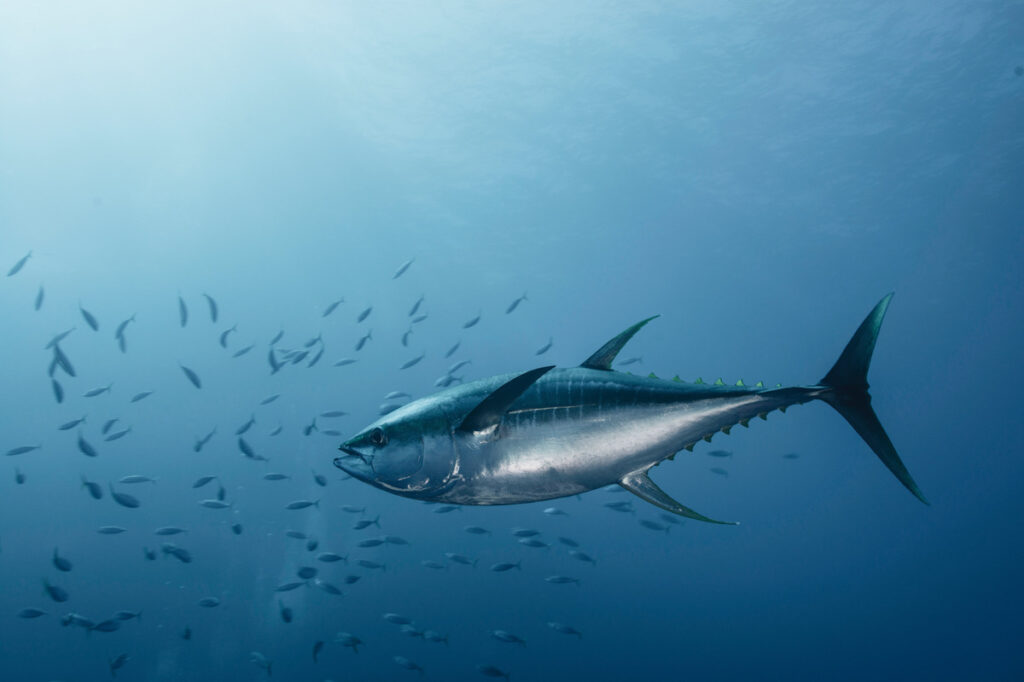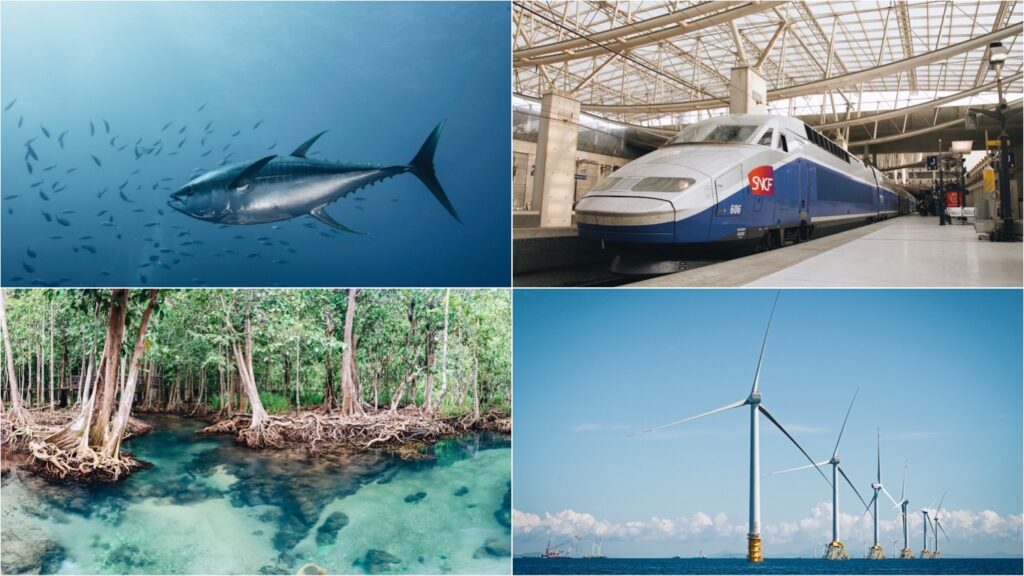It’s been yet another tough week for the planet, and all eyes are on the COP26 summit to see whether world leaders are going to finally step up and save the environment.
Fortunately, there’s been some good news, too. The U.S. could create enormous offshore wind farms on both coasts to tackle the energy crisis, while the International Union for Conservation of Nature (IUCN) has upgraded the conservation status of four of the most overfished tuna species—a huge win for the climate.
In Sweden, the wooden town of Skellefteå has built a sustainable 20-story skyscraper, one of the world’s tallest wooden buildings. Meanwhile, French trains are ditching plastic water bottles to minimize waste, and mangrove conservation is growing fast in and around the Kenyan city of Mombasa. Here’s this week’s positive environmental news.

The coastal U.S. could get huge offshore wind farms
The good news: Secretary of the Interior Deb Haaland announced plans last month that will help the Biden-Harris administration meet its goal of 30 gigawatts of offshore wind energy (that’s enough to power around 10 million homes) by 2030. Up to seven areas on both coasts of the U.S. and the Gulf of Mexico could be auctioned off to build offshore wind farms.
The impact: Wind power is arguably the most sustainable, efficient, and safe way to generate renewable energy. It not only supports a transition away from fossil fuels but creates jobs, wealth, and enables domestic growth. While wind farms can be a threat to wildlife, their efficiency makes them essential if President Joe Biden is to meet his extensive energy goals.
Did you know: The largest source of renewable energy in the U.S. is already wind power, and national capacity reached approximately 122,000 megawatts by the end of 2020—supplying just over eight percent of total electricity generation and more than 30 percent in Kansas, Iowa, North Dakota, South Dakota, and Oklahoma.
How you can help: One of the best ways to support renewable energy is to switch to a more sustainable supplier. Tariff comparison websites can help you make this decision, and Forbes compiled its own list here. The Department of Energy (DOE) plans to spend $11.5 million studying the potential environmental risks of wind farms and has been surveying those who live in the vicinity. If approached for feedback on existing or planned projects, answer honestly and raise any concerns about ecological impact directly.

Four of the most-threatened tuna species are recovering
The good news: Back in September, the IUCN announced that four commercially-fished tuna species are finally back on track due to the enforcement of regional fishing quotas and national action against illegal fishing. These measures help to prevent chronic overfishing, which particularly impacts popular seafood species such as cod, monkfish, halibut, and tuna.
The impact: The Atlantic bluefin, yellowfin, and albacore have all been transferred to Least Concern, while the Southern Bluefin has been upgraded from Critically Endangered to Endangered. Tuna are top predators and an essential part of their marine ecosystem. As a large fish species, they also store carbon in the same fashion as whales and sharks.
Did you know: Marine animal welfare is a neglected issue, and fish, in particular, are all-too-often dismissed as simplistic, near-inanimate objects. But they are as complex, sensitive, and important as any other creature. The Atlantic bluefin tuna can grow up to 15 feet long and has an estimated lifespan of over 35 years. (That’s long enough to be president.)
How you can help: While these four varieties of tuna are recovering, it’s important that the fishing industry doesn’t immediately regress to business-as-usual.
Ultimately, that is largely up to lawmakers, but individuals aren’t completely powerless to make an impact. Cutting seafood out of your diet (particularly if you don’t live anywhere near the coast) makes a huge difference for the environment and for fish populations.
Check out our guide to vegan seafood here.
A Swedish town has one of the tallest wooden buildings in the world
The good news: The Swedish city of Skellefteå offers remarkable insight into the future of sustainable architecture. It runs on 100 percent renewable energy, recycles hundreds of thousands of tons of electronic waste every year, and is set to build Europe’s largest electric vehicle battery factory in the next few years.
It is also home to a remarkable number of wooden buildings (including the airport’s control tower), the latest of which is the carbon-neutral Sara Cultural Centre—the second largest wooden skyscraper in the world. It was built by White Arkitekter, the largest architectural firm in Scandinavia, which specializes in holistic sustainability through design.
The impact: The mass-timber building contains the city’s art gallery, museum, regional theatre, and library, topped by a 20-story hotel with incredible views of the city. White Arkitekter partner Robert Schmitz told Dezeen, an architectural design magazine, that his firm designed the stunning building to be an iconic landmark for Skellefteå.
Did you know: It might seem counterintuitive to cut down trees in the creation of a sustainable building, but wood is a surprisingly climate-friendly construction material. According to White Arkitekter, a 50-year life cycle assessment of the new building showed that, overall, it will sequester far more carbon than it emits. The Sara Cultural Centre should have a lifespan of at least 100 years, double the amount included in the life cycle assessment.
How you can help: Sustainable architecture is an absolutely essential part of humanity’s future, and you can learn more about it here. However, much like how the most sustainable purchase is the one you already have, the most sustainable building is one already in existence. Learn about the RetroFirst Campaign here, reusing materials here, and the dangers of green gentrification here.

France’s national train operator is ditching plastic bottles
The good news: The state-owned French National Railway Company (SNCF) just announced that it will no longer sell water in plastic bottles on its services, instead offering recyclable cardboard containers for still water and aluminum for sparkling. The operator claims that this swap will reduce the waste produced by roughly two million drinks.
The impact: Single-use plastic is an enormous drain on the environment. Just 16 percent is actually recycled to make new plastics while 40 percent gets sent to landfills. This kills hundreds of thousands of animals every year, clogging rivers and streams as well as sewers and drains.
Because of this, the French government is taking an increasingly decisive stance on plastic waste, and this move by SNCF follows an announcement that unnecessary packaging on fruit and vegetables will be banned from January 2022. France currently produces 4.8 million tonnes of plastic per year.
Did you know: The Indian Ministry of Railways also eliminated single-use plastic from its operations in October 2019, and the Railway Board installed just under 2000 bottle-crushing machines at 360 of its major stations nationwide. India generates around 9.46 megatons of plastic waste per year, and its railways transport approximately 22 million passengers daily.
How you can help: Companies need to stop creating pointless plastic, and governments need to clamp down on production. But cutting back on purchases day-to-day is something that’s within reach for many of us. Plastic is a necessity for many people, for many reasons, but it’s still possible to reduce and reuse in your bathroom, your kitchen, and in your wardrobe.

Community efforts restore mangrove trees and bring jobs to the Kenyan coast
The good news: Mombasa’s Brain Youth Group, a community-based conservation group, is working to support mangrove trees in the southern Kenyan city. Approximately 50 percent of the trees have been lost over the past half-century, but local people are working hard to restore coverage. The Brain Youth Group, which is primarily women, also aims to provide employment and alleviate poverty within the community.
The impact: Mangroves previously covered over 1500 hectares of Tudor Creek, one of the two main water bodies separating the island of Mombasa from mainland Kenya, but only around 215 hectares are left. Brain Youth Group aims to plant 14,260,000 mangroves and has already planted nearly 501,000. The organization also provides significant training and education to community members, facilitating monitoring by skilled youth rangers and other locals.
Did you know: Mangrove forests are coastal wetlands that combine densely tangled trees and other plants. They can grow in rivers as well as out into the sea and are well-known for their often impenetrably entwined root systems and incredibly diverse wildlife. They prevent erosion and shelter marine and shore-dwelling animals alike. They also sequester 10 times more carbon than other comparable forests thanks to their complex and far-reaching roots.
How you can help: Support the Brain Youth Group’s work via the Million Tree Campaign here, and learn more about mangroves around the world here. You can also support Mikoko Pamoja, another community-based mangrove conservation group operating in southern Kenya.
Looking for more good climate news? Read the previous roundups here.


